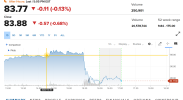Install the app
How to install the app on iOS
Follow along with the video below to see how to install our site as a web app on your home screen.
Note: This feature may not be available in some browsers.
-
Welcome to The Platinum Board! We are a Nebraska Cornhuskers news source and community. Please click "Log In" or "Register" above to gain access to the forums.
You are using an out of date browser. It may not display this or other websites correctly.
You should upgrade or use an alternative browser.
You should upgrade or use an alternative browser.
Stock Market/Investing/Day Trading/Speculative Trading Thread
- Thread starter That SOB Van Owen
- Start date
One more teeny, weeny tug on Paris' skirt and it's "show time" ...
Last edited:
The Russell 2000 is performing terribly — why that could be bad news for the stock market
Bigger isn't always better.
I dumped about half of the shares that I'd previously held in a small cap fund just before New Year. Just wish I'd waited a little longer before buying anything else...
Inflation is a thing. So is highway robbery...
Edit: facepalm, you can read the article by clicking through from Google News, but apparently not from a direct link. Fuck it, here's the text:
Edit: facepalm, you can read the article by clicking through from Google News, but apparently not from a direct link. Fuck it, here's the text:
Tyson Foods loves inflation
When it comes to drawing conclusions about the state of the economy, it’s often tempting to stick to the established economic metrics — from unemployment, to labour force participation, to CPI — as a basis for your opinions.
But at FT Alphaville, we also believe something can be gleaned about the economy from looking at company data, particularly of those who play such an important role in their local economies.
Speaking of which, $32bn Tyson Foods — America’s largest producer of chicken, pork and beef — announced its first-quarter results before the bell Monday morning. And they were blow out.
Revenues grew 24 per cent year on year, coming in at a shade under $13bn, versus analyst’s expectations of $12bn. While earnings per share tripled to $3.70, comfortably exceeding the $1.94 Wall Street’s finest had pencilled in. In early trading, the shares are up 12 per cent at $98.64.
However, what piqued our interest wasn’t Tyson’s top or bottom line growth, but how it got there and, more importantly, what it says about the effect of inflation on some American businesses.
It feels obvious to state but for commodity product producers such as Tyson, revenues are simply what you get when you multiply the number of goods sold (aka the volume) by the prices its customers pay.
So how did that break down for Tyson and its Amazon-esque 24 per cent revenue growth?
Well, here’s the key table from its earnings release:

Cast your eyes over to the second last row in the table — volumes were muted across all its key operating segments bar its international business. The number of beefy goods sold even declined 6 per cent. The reason? Well, for both cow flesh and things that cluck, Tyson cited a “challenging labour environment”. Or, in layman’s terms, it was struggling to get the bodies needed to produce.
Now, a decline in a volumes sounds bad, until you look at those price increases in the final row. Holy cow!
The average price charged per customer for beef was up 32 per cent year on year, pork 13 per cent and chicken 20 per cent. While wages, along with meat and logistics prices have risen substantially, Tyson’s pricing power more than made up for those higher production costs. The company recorded an operating profit margin of 11.3 per cent — only the fourth time since 1990 that this figure has been in the double digits, according to data from S&P Global.
Of course, as the largest company in one of the most consolidated industries in the US, Tyson is in an enviable position where it can use price increases to ameliorate any supply chain issues it might be suffering from.
But it is a reminder that in an economy where both wage growth and supply chain bottlenecks are driving inflation, businesses that sell things that people want cannot only deal with the higher costs, but thrive from them.
Just don’t tell Elizabeth Warren.
Key Supplier of Wafers for Chips Has Sold Out Through 2026
(Bloomberg) -- Sumco Corp., a key supplier of silicon wafers for the semiconductor industry, said it has already sold out its production capacity through 2026, a sign shortages in the industry may not abate for years.Most Read from BloombergHere’s What the Pandemic Has in Store for the World...
Outside of folks buying used cars out of necessity, anyone spending these prices on used cars is an absolute lunatic haha.
Outside of folks buying used cars out of necessity, anyone spending these prices on used cars is an absolute lunatic haha.
its crazy my old man sold his 2014 Avalanche (it was a piece of shit) for $5k more than he bought it for in 2016
*Disclaimer: they stopped making the Avalanche so maybe this is partially the reason
Fuck I would typically buy a new car right now, but I am not paying that. Fucking zombies walking in paying for it.Outside of folks buying used cars out of necessity, anyone spending these prices on used cars is an absolute lunatic haha.
JFC…. The guy is borderline mentally handicapped. @hardlyboy GITT and defend your guy! 🤯
Last edited:
Similar threads
- Replies
- 17
- Views
- 787
- Replies
- 13
- Views
- 1K
- Replies
- 2
- Views
- 520
- Replies
- 31
- Views
- 2K






